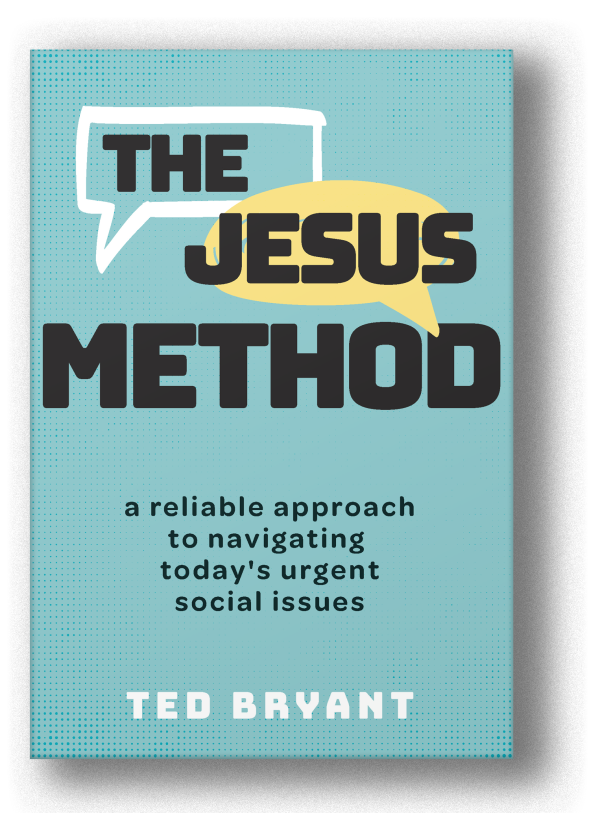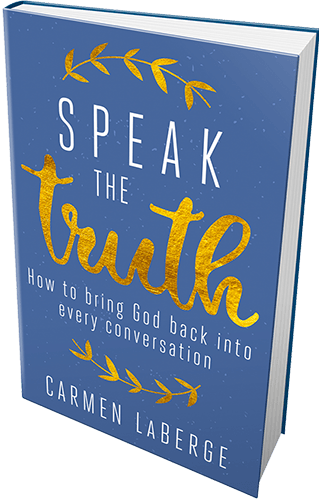Are you ever intimidated or you just want to clam up and run away from sticky conversations? Or maybe even not tell the whole truth in the midst of the pressurized conversations of the day? You don’t want to offend anybody, but you also want to engage as a Christian in these conversations.
What we most want— is to be Jesus-y! So how do we do that? How do we walk and talk like Jesus in the social dilemmas of our day? Well, what if we learned how he did it in his day?

Ted Bryant, a pastor and author, over the course of time, has studied the scriptures and learned how to navigate some of the urgent conversations of the day with what he calls the Jesus method. He brings forward the way Jesus approached tough conversations in his book The Jesus Method.
This is an edited excerpt. To hear the entire interview, listen online at MyFaithRadio.com, on the My Faith Radio App or wherever you get podcasts.
Carmen: Ted, you examined the gospels because you were looking for how did Jesus actually deal with the challenges that we now face? So talk with us about your journey into discovering the Jesus method and then let’s unpack it.
Ted: We oftentimes can either feel like I need to run and hide. I don’t want to hurt someone’s feelings. I don’t want to offend somebody. And so we think that the loving thing to do is just to be quiet, just to be silent. And the problem is, as I was searching through the Gospels, I did not see Jesus do that. However, the other thing that we might be tempted to do in our life if we don’t want to be silent is just to be as loud as possible about where we stand, why we stand there, and how no one dares move us. And that we will make sure as often as possible, we will be as loud as we can about where we are and what we believe is right and wrong. And again, the problem is as I look through the gospels, I didn’t see Jesus do that either.
And so I felt stuck. And as a Christian, as a Christ follower, I wanted to understand the Bible better. I wanted to make sure I was growing in my faith. And so how did Jesus, who seems to be almost like the Houdini of getting out of social dilemma traps—I mean people all the time tried to pin him down and trap him and confuse him— and somehow he made it out. If there’s a pattern in how Jesus did this, could we take that in our own life, apply it right where we are in the social dilemmas of today? And sure enough, as I reached it, researched it through God’s grace, there is a method. And so I wanted to write it down just to encourage other people the way that I’ve been encouraged.
Carmen: That is so good. Alright, so Ted, why don’t you just briefly tell us what the method is, and then would love to get into some of the weeds with you, but what is the method when we talk about the Jesus method, even when people were trying to trap him, even when people of differing viewpoints were coming at him simultaneously, what was the methodology of Jesus?
Ted: One of the things that we see as we look at all of these different instances that you’re referring to is Jesus always had a routine of prayer that it was a common thing that he did. Several times in the Scriptures it mentions Jesus went off to pray as he often did, as if the riders are just saying, oh yeah, there he is, praying again. I mean, we need to mention it. He does it all the time. And so before we get into the actual intensity of a particular moment, we have to understand that the foundation of the Jesus method, the foundation for us as we enter into all these heated conversations is prayer. There needs to be a bedrock of conversation with God that prepares us, prepares our heart, mind, soul, spirit to enter into these dilemmas. And so that’s the first step is actually prayer.
And then the second step is very important to understand. Jesus saw the questioner behind the question. There’s always a questioner behind the question. And he made a determination of the context of that individual. Were they a part of the family of God? In other words, how Jesus described the family is, are they wanting to do the will of God the Father? Are they claiming to be a follower of Jesus or a follower of the way? And if so, then he would treat them slightly differently. Now, if they were not claiming to be a part of the family of God, they were not claiming to be a follower of Jesus, then he would treat them as a, is what I refer to in the book that they’re not in the family yet, but what they are invited. They are invited, they’re just not in the family yet.
And so depending on the context of family or guest, Jesus would interact with them differently for the family, he would challenge them and he would empower them. And then for the guest, he would actually meet their needs right where they are. That’s the first step he would do. And so one of the things that I noticed is this contextualization that Jesus has for those he interacts with is massively different than our natural instincts in today’s conversations where we just want to again either retreat and be silent or we want to overpower someone with our stance. And again, neither one of those is part of the method. And so that’s step one, step two, and then we have lots of other nuances of the method, but one of the ones I want to highlight is that the goal is always relationship. The goal is always relationship with Jesus.
And to be clear, it’s relationship the way God has defined it, it’s not relationship based on how someone else thinks it’s supposed to go. For instance, I’ve had individuals say, well, if you don’t agree with me, then you don’t love me. Well, that’s not how God defines relationship. What you see in Jesus is as he either challenged and empowered the family or as he met the needs of the guest, he was actually loving them and willing to let them walk away from time to time. And that’s really hard.
Carmen: Yeah, it’s so good. We’re learning so much just in listening to you talk about how Jesus engaged with individuals. So he’s establishing this regular rhythm of prayer. He’s getting time with the Father. And so we want to establish a foundation of prayer. And so I want you to ask yourself this morning, what’s my ongoing conversation with God look like? Have I already spent time one-on-one this morning with the Father in communion with him, recognizing that I’m going to encounter people today, some of whom are going to be inside the family of faith, they’re going to be fellow brothers and sisters in Christ, and others are going to be in some way proximate to but not in fellowship with. And how does that difference in relationship, how does that difference in their context, how does that influence how I engage with them, not only speaking the mind of Christ, but also in the character in the ways of Christ?
Carmen: Sometimes Ted, we frankly just want to slay the other person. And that’s really, that’s not the spirit of Christ. So talk with us about that— it’s not just what we say which is important and critical. We want to be people of truth and goodness and beauty, and we want to say the right things, but we also want to say them in the right way. Can you talk with us about how he said it?
Ted: Absolutely. We all, I think many times, want to feel like I want to defend God. I want to make sure that I’m not letting him down. I’m not ashamed of what I believe. And yet what I’ve come to a conclusion about is that when we do not know the way of Jesus, we can weaponize the truth of Jesus when it’s just about what is right and wrong and that overpowers how we’re supposed to communicate that it can be very dangerous. And we actually see this in scripture. We see the Pharisees coming to Jesus. It’s one of the social dilemmas that he finds himself in with a woman caught in adultery. And they are coming at him with the truth. What is right and wrong? This is an easy lob for Jesus to just follow the law of Moses. She needs to be disciplined for this.
And this is oftentimes what is in all of our hearts. But what we see Jesus do in that moment, again, he sees the person behind the problem. He sees the relationship potential in the heart of the woman who is caught, and that is where he places his focus. You see, when we are all about establishing power, then we make things public. But when we are really seeking the heart of a person, we make things personal and that’s what we see Jesus do. He takes it out of a public context. Hundreds of people probably watching this scenario on the south temple steps of some sort. And yet he brings it down into a one-on-one conversation with this woman and he forgives her. He provides what she needs, but then he says, go and sin no more. He does not dilute the truth. It’s just how he communicates. It was kind and loving, full of love, full of grace and full of truth.
Carmen: And we just live in a world where, I mean you and I both know this, people are generally full of it. And so I think that part of what you’re encouraging us to do is to be full of grace and truth. And sometimes we overwhelm with truth and we don’t demonstrate grace. And sometimes we just err on the side of grace and we never speak the truth. So finding equal footing, finding our balance in these conversations and then walking with confidence into the conversations of the day is something you are really equipping us to do with the Jesus method. If you could tell our friends who are listening right now, one thing about the Jesus method, what do you want to make sure they know in our conversation today
Ted: That we can all do this. Jesus makes truth simple. He’s not trying to confuse anyone. And when you go through the material in the book, I think it’ll be so enlightening– oh, I can do this one relationship at a time with the help of the Holy Spirit. I can actually do this. I don’t have to feel stuck anymore, especially with those that I care about and I love. I want to make sure they know where I stand, but at the same time, I want to make sure I’m not pushing them away. We can actually do this. I had a friend of mine tell me one time, truth without grace kills; grace without truth lies. And we’re not supposed to do either one of those. And Jesus shows us a way. And I believe, which is one of the reasons why I wrote the book, I believe we can all do this. And when we do this, it truly helps bring the way of Jesus into our everyday life.
Listener’s Guide: What’s Next?
After hearing an interview like this one, it can be easy to move on to the next thing on our to-do list, but instead, let’s take a moment to pause, reflect on what we have heard and consider how God might be asking us to respond.
Reflect
- Do you ever feel “stuck” when it comes to sticky conversations, like Ted describes? What are the emotions or fears that are causing you to clam up and avoid conversations with others?
- Spend time looking at example of Jesus, as found in the gospels, and how he would approach these types of conversations. How does looking at Jesus help move you past stuck?
Pray
- Ted points out that the first and foundational step modeled by Jesus is prayer. He had a regular rhythm of getting away to spend time with the Father, so consider the health of your own prayer life. If you have not already, begin praying specifically for these potential conversations that He may have put in your path.
Act
- Practice the Jesus Method! How might your conversations change if you sought to follow the model Christ gives us: seeking first to understand, engage the person, not the problem and make relationship (not winning the conversation or impressing with facts and arguments) the central goal.



